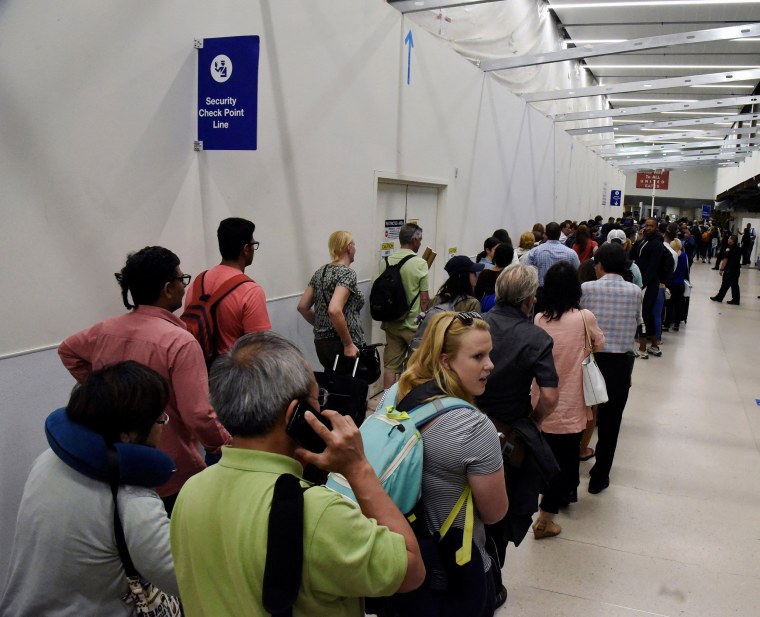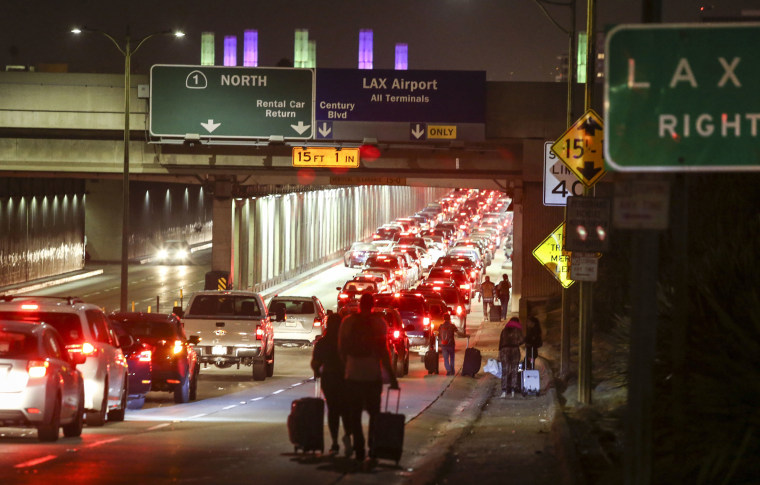"If you see something, say something," homeland security officials urge the American public.
But what if "something" starts everybody running, and it's at an airport, and then it turns out that there was no danger in the first place?
This is not a hypothetical. It has happened three times at major airports this summer, the latest at Los Angeles International on Sunday, when rumors of gunfire sent thousands of people fleeing from terminals and onto airfields and roads, forcing authorities to stop flights and send all travelers back through security checkpoints.
Similar panics unfolded at New York City's John F. Kennedy International Airport: a mistaken report of shots fired on Aug. 14 and a false bomb scare on June 29.
Anthony Roman, who runs a security consulting firm in New York, was caught in the June scare — the result of a bomb-sniffing dog being drawn to an unattended bag — and has watched coverage of the two other false alarms with growing concern that safety officials are failing the public.
"Letting hundreds of people loose onto an active tarmac, an environment they're absolutely unfamiliar with, and allow them to go on open roadways while traffic is still moving, is obscene," Roman said.

Each case made it appear that security personnel did not give enough direction, or protection, to people rushing from the airports, making the evacuations resemble the blind leading the blind, Roman said. It revealed what he saw as insufficient protocols and training.
"There's an awful lot to be learned and an awful lot that is going wrong, which is unforgivable given that we are a decade-plus past 9/11," Roman said.
Henry Willis, director of the RAND Homeland Security and Defense Center, came to a similar conclusion.
"I think that when I look at these events, it has to be recognized as a public safety failure," Willis said.
It's understandable to see how frightened travelers, seeking the fastest way out of an airport, would run through jetways and security checkpoints and then into areas where planes and cars are operating, Willis said. But there's no question those people often end up in harm's way — and it's up to authorities to prevent that, he said.
A pause, in order to discern the nature and validity of the threat, would help, Willis said. Otherwise, if such evacuations continue to occur, the public is at risk of becoming accustomed to them, risking a lackluster response when a threat is real.
"These events show that we need to examine if our crisis communication protocols are sufficient," Willis said.
The Port Authority of New York and New Jersey, which runs and polices JFK, did not return messages seeking comment on Monday. Neither did the Los Angeles Airport Police Division.
Marshall McClain, president of the Los Angeles Airport Peace Officers Association, the union that represents LAX cops, acknowledged that it was not ideal to have passengers on the tarmac or near roadways. He said his organization would continue to look at how to best handle such situations — although it's probably impossible to avoid the running-herd mentality in such scares. "If anyone sits here and tells you what they're doing is the best there is, then they're foolish," he said.
One possible fix is arranging "corral" areas on the tarmac to ensure evacuees' safety, he said. Another, one that officers in New York and Los Angeles have demanded, is that cops be given access to all live security camera footage, which they say would allow them to identify the source of a threat, real or perceived.
Rick Mathews, professor at the College of Emergency Preparedness, Homeland Security and Cybersecurity at the University at Albany, was less critical of authorities, saying there wasn't much they could do once people started following the instinct to flee a threat.
"It's easy to be outside and be critical of what happened, or be extremely opinionated about what occurred without having all the facts," he said.
It would be worse if officers under-reacted, and the threat turned out to be real, Mathews said. And a deadly airport scenario is becoming increasingly plausible, given real attacks in Turkey and Brussels this year, and the 2013 shooting at Los Angeles International in which a Transportation Security Administration officer was killed.
"If there had been an active shooter, they would have minimized casualties," Mathews said.

